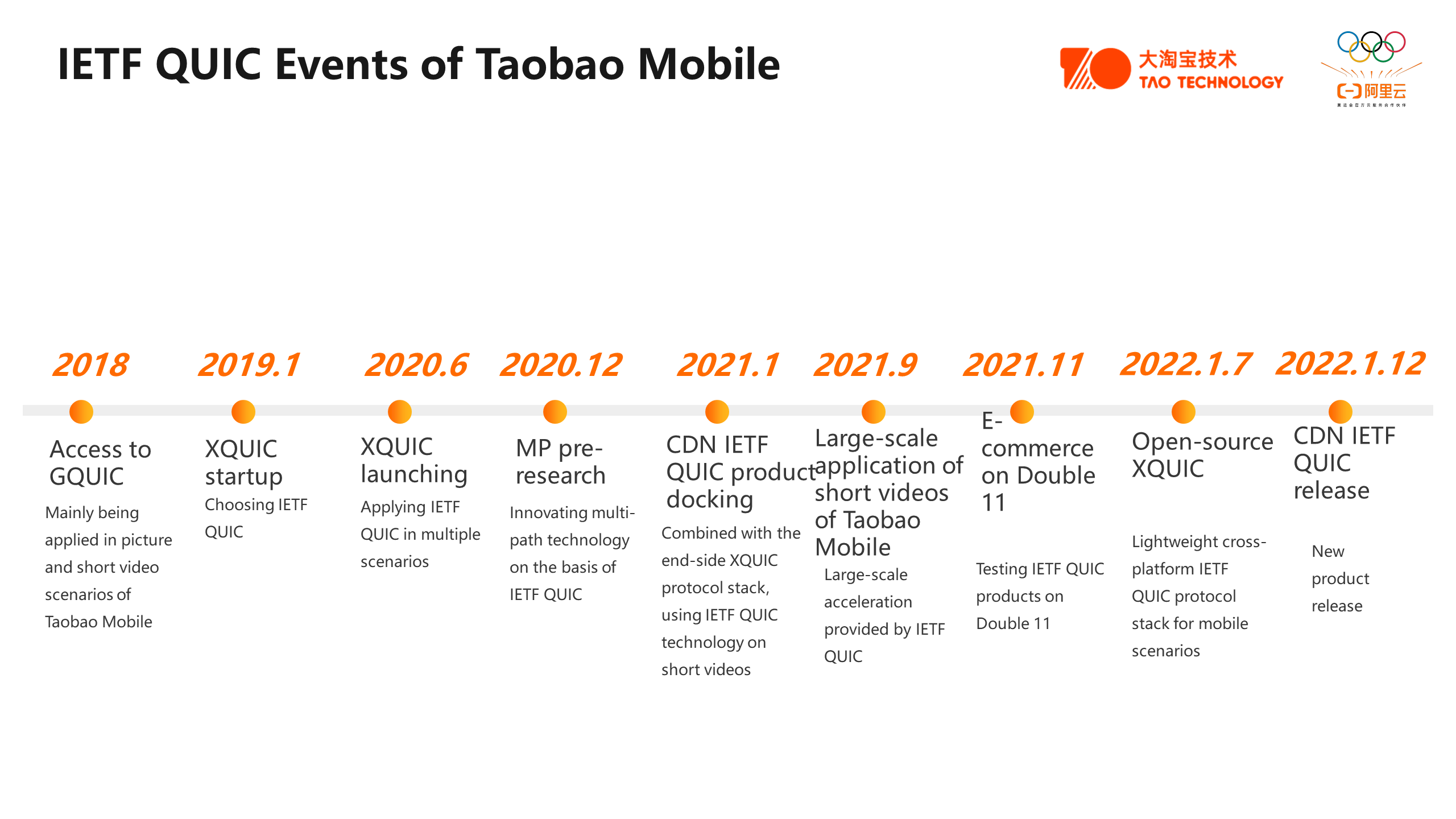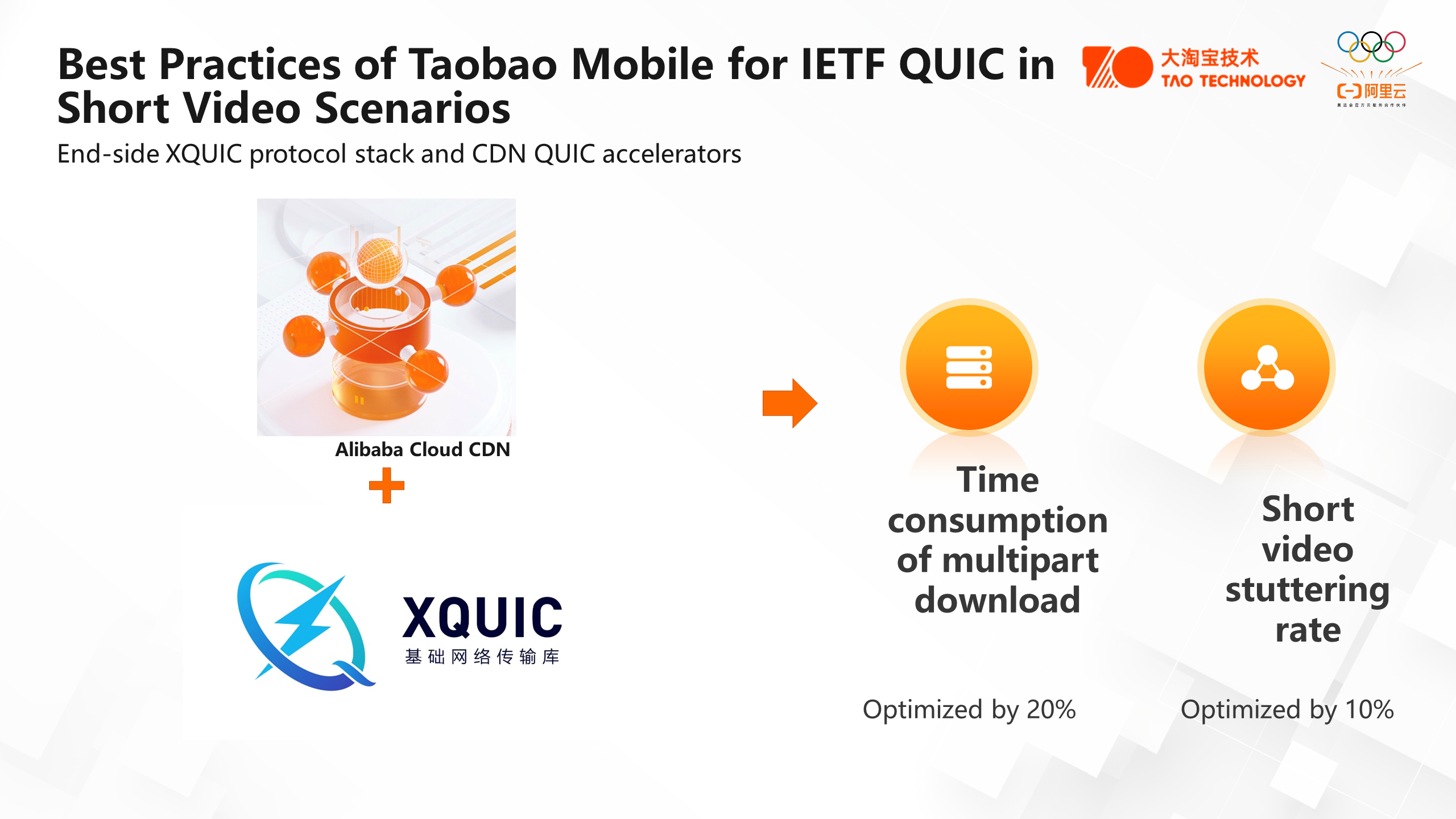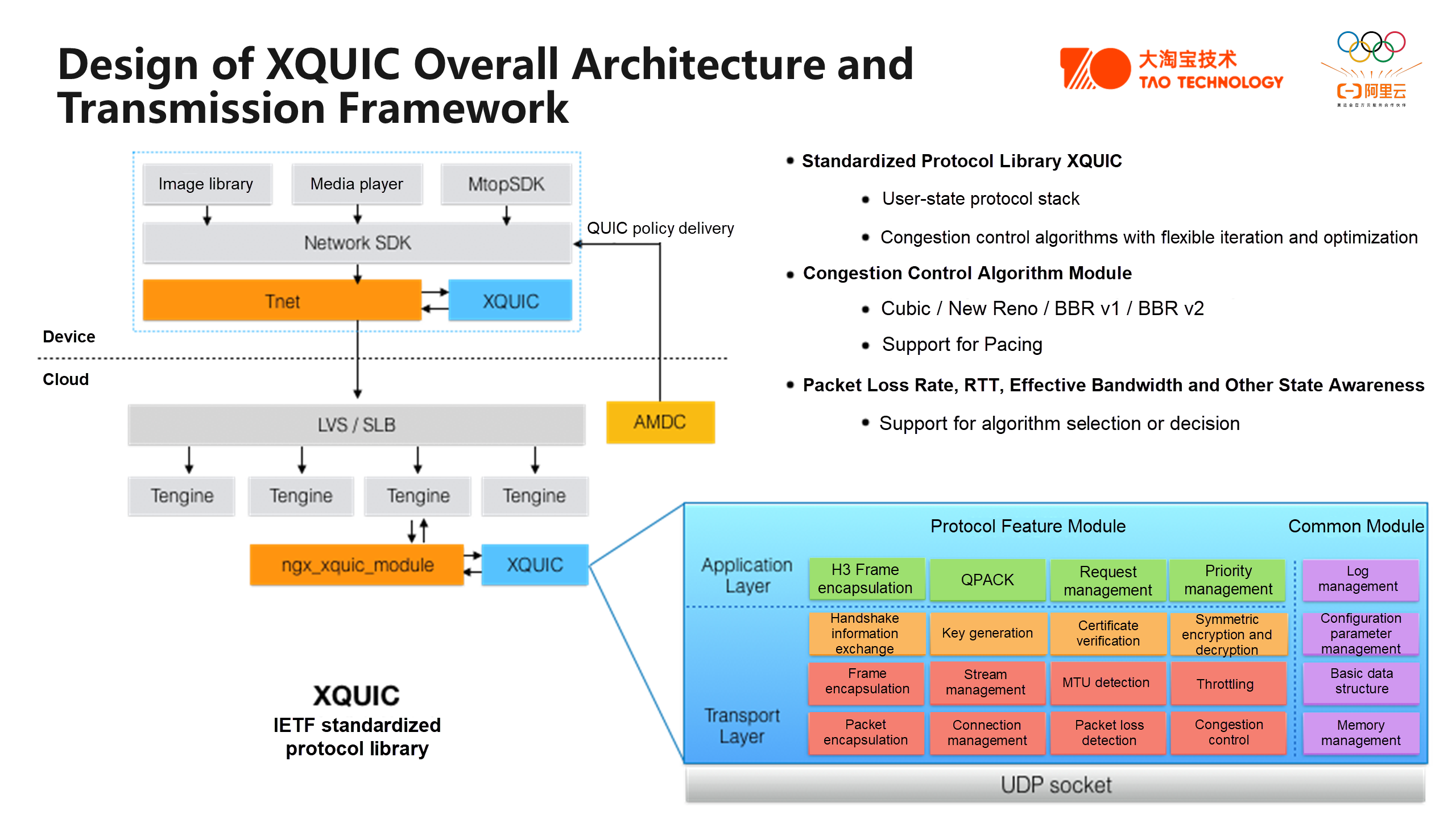By Miaoji
Taobao Mobile uses Alibaba Cloud Content Delivery Network (CDN) in multiple scenarios, such as short videos and pictures. There are many co-construction and cooperation between Taobao Mobile and Alibaba Cloud CDN in technologies, including IETF QUIC accelerators. On January 12, at the product launch of Alibaba Cloud CDN Upgrade | New-Generation Transmission Protocol QUIC Makes CDN Faster, Miaoj, (from the Technical Team of the Big Taobao Platform and responsible for Taobao Mobile network and gateway technology), shared the application scenarios and effect of Taobao Mobile using IETF QUIC accelerators and introduced the matching XQUIC library. The following is the full transcript.
In retrospect, in 2018, Taobao Mobile and Alibaba Cloud began to cooperate in GQUIC, which was used in content delivery scenarios of Taobao Mobile, such as pictures and short videos. At the beginning of 2019, there was a common judgment that we should focus on standardization. On the one hand, from the perspective of commercial products, private protocol solutions are more difficult to be recognized by users. On the other hand, the design and security of the whole standardized protocol are more mature. After deciding to choose the standardization, the market did not have a particularly mature and suitable implementation of the IETF QUIC protocol stack on the mobile side at that time. Therefore, Taobao Mobile started its XQUIC project. After one and a half years of R&D and polishing, XQUIC was fully launched in June 2020. In early 2021, it was docked with CDN IETF QUIC products. It has gradually applied IETF QUIC technology to short video scenarios. In September 2021, we realized the large-scale application of the IETF QUIC protocol stack in short video scenarios. After that, we experienced Double 11 later in the year when the performance and stability of XQUIC and CDN products were well-verified. Therefore, we made XQUIC open-source on January 7, 2022. We also support the release of new products of CDN IETF QUIC.

Currently, Taobao Mobile mainly uses CDN QUIC accelerators in short video scenarios. The best technical solution is together using the end-side XQUIC protocol stack and CDN QUIC accelerators. The optimized effect for network experience is that the time consumption is optimized by 20% for multipart download of short videos, and the overall stuttering rate is optimized by 10% for short video scenarios of Taobao Mobile. Considering the overall optimization effect is very obvious, we will continue applying this set of acceleration technology in scenarios (such as images). At the same time, we are willing to share this set of best practices with all of you, hoping to bring a better network acceleration experience to cloud product customers.

Below are the details on the performance and benefits of QUIC.
I will briefly introduce the XQUIC library used on the best practice side. XQUIC is a lightweight, high-performance, standardized cross-platform protocol library.
In the case of being lightweight, compilation products of XQUIC in Android and iOS are less than 400KB. Mobile applications are expected to minimize the package size to reduce the installation cost for new users. Thus, XQUIC is very suitable for mobile applications that require high performance but are sensitive to package size.
Speaking of high-performance transmission, XQUIC has already realized the large-scale usage of core shopping guides and short video links on Taobao Mobile. For example, when we open the homepage of Taobao Mobile to search for goods we are interested in or browse influencer videos, XQUIC provides faster network data transmission for these scenarios.
In terms of standardization, XQUIC implements a complete set of IETF QUIC standard protocols, including the transport layer, encryption layer, and application layer protocol stack.
As far as being cross-platform, our network library supports Linux, Android, iOS, MacOS, and other platforms. Windows platform will also be adapted later. Clients can easily access and use XQUIC via SDKs.

As mentioned earlier, XQUIC provides the three-layer protocol stack capabilities included in the IETF QUIC standard. It runs on the client as an SDK. On the server, it can be docked to the Tengine or Nginx framework by module.
In addition, we have done a lot of extra work on protocol interoperability, 0-RTT ratio improvement, and compatibility of plaintext and ciphertext modes for scenarios where mobile ends use CDN. For example, in terms of compatibility between plaintext and ciphertext modes, we support the encryption suite recommended by standard TLS/1.3 and provide plaintext mode. In addition, automatic rotation negotiation can be realized in the handshake phase, negotiation can be realized through transport parameters in the handshake phase, and compatibility with standard ciphertext mode can be guaranteed. In terms of increasing the 0-RTT ratio, we optimized the cache policy of server configuration and token, so the 0-RTT ratio can reach 68% or higher on the wireless side.
We believe the cooperation between the XQUIC protocol library and CDN QUIC accelerators can offer users a smoother network transmission experience.
Alibaba Cloud Brings New Innovative Solutions to Accelerate MENA Digitalization

1,113 posts | 337 followers
FollowAlibaba Cloud Community - December 2, 2024
淘系技术 - November 17, 2020
Alibaba Clouder - October 27, 2020
Alibaba Clouder - December 23, 2020
Alibaba Clouder - October 12, 2020
淘系技术 - November 17, 2020

1,113 posts | 337 followers
Follow Mobile Testing
Mobile Testing
Provides comprehensive quality assurance for the release of your apps.
Learn More mPaaS
mPaaS
Help enterprises build high-quality, stable mobile apps
Learn More Content Delivery Solution
Content Delivery Solution
Save egress traffic cost. Eliminate all complexity in managing storage cost.
Learn More Super App Solution for Telcos
Super App Solution for Telcos
Alibaba Cloud (in partnership with Whale Cloud) helps telcos build an all-in-one telecommunication and digital lifestyle platform based on DingTalk.
Learn MoreMore Posts by Alibaba Cloud Community